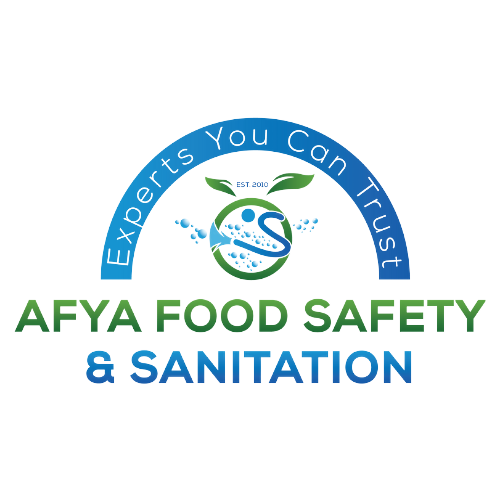
Please Wait For Loading

Please Wait For Loading
Maryland, MD USA
+1 (443) 666-9132
info@afyafoodsafety.com
Opening Hours: 9:00 AM - 5:00 PM
Copyright ©Afya Food Safety all rights reserved.
You can also reach us via Phone: +1 443 666 9132 or via Email:info@afyafoodsafety.com
Food Safety Measures
Safe and nutritious food is key in sustaining good health and life. Food contaminants such as harmful bacteria and viruses can cause More than 200 different diseases ranging from diarrhoea to cancers. According to World Health Organisation (WHO) statistics, almost 1 in 10 people fall ill after eating contaminated food each year, resulting in 420 000 deaths.
What is Food Safety?
Food safety refers to conditions and measures necessary to preserve the quality of food from production to consumption. These measures prevent contamination and food-borne illnesses.
Contamination
Contamination occurs when food contains microorganisms such as bacteria, parasites or toxic substances that make it unfit for consumption.
How does food get Contaminated?
Contaminated food can have dire consequences for the person who eats it and the business that sells it. Food contaminants can either be Biological, Chemical or Physical in nature.
Food contamination can occur during the processing, packaging, transportation or storage phase in the production cycle.
Chemical Contamination
Chemical contamination occurs when there are chemicals present in food.According to the National Center for Biotechnology Information(NCBI) Chemical food contaminants are substances which are neither present naturally in the usual raw material used for food production nor are added during the regular production process. Contamination can be as a result of;
Biological Contamination
Biological contamination can be bacterial, viral or can be caused by a parasite. The contaminant can be transferred to food through saliva, pest droppings, blood or faecal matter. Most food poisoning and spoilage is caused by a biological contaminant. High risk foods are more vulnerable to bacterial contamination. This is because they are;
These foods include meat and poultry,seafood,dairy products and eggs.
Physical Contamination
When harmful objects contaminate the food it leads to physical contamination. These objects may include hair, glass, metal , pests, jewellery, dirt and fingernails .
Ensuring Safety in Food processing
1)Educate staff sufficiently
Staff should be trained on how to ensure food safety to help reduce the risk of contamination.Regulations require that food handlers are supervised and trained in Hand hygiene ,Safe food storage practices, Safe food handling practices,Cleaning for food safety and Pest control.
2) proper handling, storage and transportation
There are a range of factors that need to be considered during handling, storage and transportation to ensure that food products do not become contaminated. During these stages you must remember to regulate the temperature, keeping cold food cold (below 5℃) and hot food hot (above 60℃), to prevent the deterioration of the produce.
3)Personal hygiene
Bacteria easily spreads through biological and physical contamination. Therefore food handling businesses ensure:
4)Waste management
A key factor in food safety is putting into place legal procedures to store and dispose of waste. Providing appropriate containers; suitable, secure waste storage areas and establishing adequate procedures for waste removal on a regular basis. Accumulation of waste could attract pests, increasing the risk of contamination.
5)Regular cleaning
Cleaning and disinfecting food preparation areas, machinery and equipment used during food processing is essential to reduce the risk of contamination.
6)Environmental hygiene
Although food preparation areas, machinery and equipment should be regularly cleaned, this creates the possibility for chemical contamination during food production. Because of this, measures should be put in place to help prevent accidental environmental contamination.
7)Design and location
It is important to consider the design and location of your facility to ensure that you meet the correct food safety standards. Areas that are known to be pest infested as well as prone to pollution, should be avoided to reduce the risk of contamination.
8)Machinery and production lines
The design of the machinery used for food processing should comply with the food safety regulations. The production line layout should also allow easy maintenance and and cleaning of machinery and the surrounding. This will prevent contamination of products and ingredients in production.
9)Maintenance
It is essential to perform regular checks on food processing machinery and conduct regular inspections. The machinery should be checked for signs of wear and tear or damage from pests and any issues addressed.
10)Pest control
Insect,rodents,birds and animals can quickly contaminate produce with foodborne illnesses or damage machinery. The production facility should be kept clean to keep them away from the establishment.
How Afya Food Safety can Support your food safety needs.
Afya Food Safety offers tailored solutions to fit your needs.We are certified experts that:
Click here to learn more about Food Safety Consulting services.
Sources:
https://www.ncbi.nlm.nih.gov/pubmed/15378171
https://www.fda.gov/animal-veterinary/biological-chemical-and-physical-contaminants-animal-food/biological-hazards
https://www.foodsafety.gov/
https://www.who.int/health-topics/food-safety/
Related Posts
Categories
Maintaining the Sweet Spot: Bakery Cleaning and Sanitation
April 15, 2024Elevating Standards in Professional Commercial Cleaning Services
March 14, 2024Calender